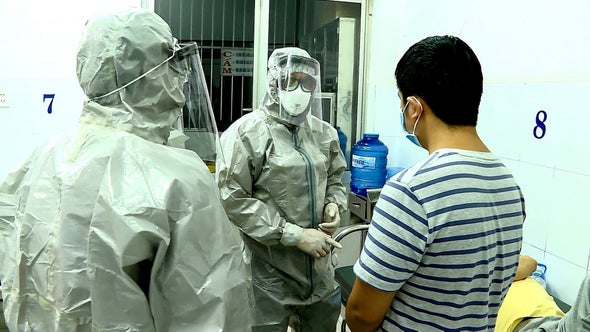Want to Prevent Another Coronavirus Epidemic?
(Posted on Thursday, January 30, 2020)

Health workers in Vietnam talk with people who have tested positive for coronavirus.
Once again we stand unprepared as the third epidemic of a new and deadly coronavirus races around the world. This need not have been the case.
We should have learned from the SARS epidemic of 2003, which claimed nearly 800 lives, that coronaviruses can turn deadly. Until then, most health officials and scientists regarded coronaviruses simply as one of many causes of the common cold; some 30 percent of common colds start from coronaviruses. Then came the MERS epidemic in the Middle East in 2012, a coronavirus that killed 858 people. The irrefutable lesson from SARS and MERS: coronaviruses can spread quickly and be deadly.
Why, then, is there no way to prevent or treat the disease in 2020? Science had the tools in the immediate aftermath of the previous two epidemics to develop the drugs to control future outbreaks. But health officials, scientists and governments, especially but not only in the United States and China, dropped the ball.
There is no doubt that coronaviruses are wily opponents. Like all viruses of this type, the coronavirus mixes and matches components to create novel versions of itself. Bats are the natural hosts of the virus. There are more than 1,100 species of bats, each infected with one or more coronavirus variants. Think of the virus as a genetic safecracker, constantly evolving new combinations to extend its range and find new host species. Humans are on that menu. Each infection, deadly or not, is different from the last, which makes an effective vaccine or cure for the whole family of coronaviruses highly unlikely.
Though we may not be able to develop a cure for those already ill, we can develop drugs that will prevent the disease from spreading. If we had done so after SARS and MERS, governments could have stockpiled the drugs years in advance of this latest outbreak and within one-day delivery to all locations where the virus has been detected or suspected. All patients, hospital workers and any other persons suspected of contact would have been treated to stop the epidemic in its tracks.
I led the effort to develop an effective drug to prevent and treat anthrax following the 2001 attack and was a pioneer for the concept of using drugs to prevent transmission of HIV/AIDS from mother to child and between adults. Assessing the genome of this new virus, I see what we describe as a “target-rich” environment; that is, a virus that has many vulnerabilities to antiviral drugs, similar to those that have been exploited successfully for the treatment of HIV, hepatitis B and herpes viruses. The drugs, or combinations of drugs, that control those diseases bind and block the enzymes the viruses need to grow.
These enzymes are very similar to one another in all coronaviruses. This is a critical point. This common molecular pattern of all coronaviruses makes the challenge of identifying drugs to control coronaviruses less daunting. Scientists design drugs to inhibit the growth of specific virus enzymes. Once the genetic code of a virus has been sequenced, the targets for effective drugs appear.
We now have witnessed three deadly coronavirus outbreaks in humans within 17 years. Once this new epidemic has faded into memory, will it be five or 10 years until the next one? We can and must develop, test and stockpile combinations of drugs that can protect against what is certain to be another coronavirus outbreak.
In the wake of the 9/11 attacks, the U.S. government established the legal authority and executive process to do this. Known as BioShield, the program authorized funding to develop and stockpile effective means to prevent and treat “new and emerging biological threats.” BioShield works. At Human Genome Sciences we developed the drug Abthrax to prevent and cure anthrax infections after the 2001 attacks. That drug is now stockpiled by the government. BioShield created the market for our work, committing many millions of dollars in purchase orders.
The coronavirus is not now and has never been on BioShield’s approved list of “new and emerging biological threats.” It should have been added after SARS, then again after MERS. It should be added now. We have been forewarned.
The departments of Homeland Security, Health and Human Services, and Defense should convene a working group immediately to add coronaviruses to the BioShield agenda. The Centers for Disease Control and National Institutes of Health then can initiate contractual discussions with the biopharmaceutical industry. Biopharmaceutical companies have the expertise to create the drugs we need quickly to prevent a fourth outbreak.
Collectively, scientists at these agencies and companies then can, and will, soon identify the drugs and produce the stockpiles that we need, that the world needs, to prevent a fourth deadly outbreak from a coronavirus, any coronavirus.
Read full article on Scientific American
Originally published on Scientific American (January 29, 2020)

